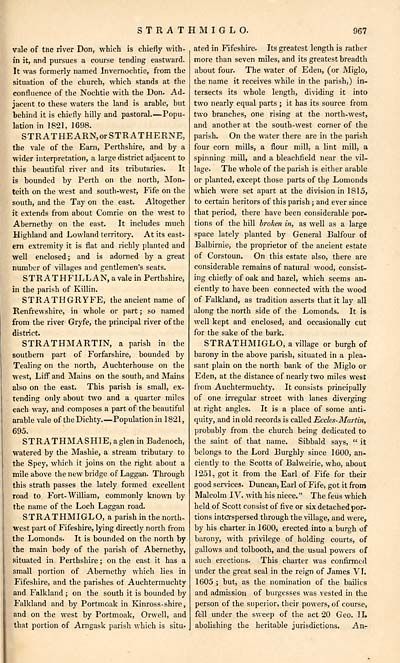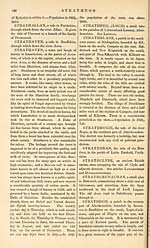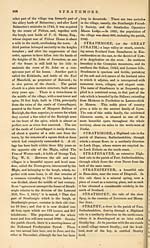Gazetteer of Scotland > Volume 2
(489) Page 967
Download files
Complete book:
Individual page:
Thumbnail gallery: Grid view | List view

STRATHMIGLO.
967
vale of tne river Don, which is chiefly with-
in it, and pursues a course tending eastward.
It was formerly named Invernochtie, from the
situation of the church, which stands at the
confluence of the Nochtie with the Don. Ad-
jacent to these waters the land is arable, but
behind it is chiefly hilly and pastoral. — Popu-
lation in 1821, 1698.
STRATHEARN,orSTRATHERNE,
the vale of the Earn, Perthshire, and by a
wider interpretation, a large district adjacent to
this beautiful river and its tributaries. It
is bounded by Perth on the north, Mon-
teith on the west and south-west, Fife on the
south, and the Tay on the east. Altogether
it extends from about Comrie on the west to
Abernethy on the east. It includes much
Highland and Lowland territory. At its east-
ern extremity it is flat and richly planted and
well enclosed; and is adorned by a great
number of villages and gentlemen's seats.
STRATHFILLAN, a vale in Perthshire,
in the parish of Killin.
STRATHGRYFE, the ancient name of
Renfrewshire, in whole or part ; so named
from the river Gryfe, the principal river of the
district.
STRATHMARTIN, a parish in the
southern part of Forfarshire, bounded by
Tealing on the north, Auchterhouse on the
west, LifF and Mains on the south, and Mains
also on the east. This parish is small, ex-
tending ordy about two and a quarter miles
each way, and composes a part of the beautiful
arable vale of the Dichty. — Population in 1821,
695.
STRATHMASHIE, aglen in Badenoch,
watered by the Mashie, a stream tributary to
the Spey, which it joins on the right about a
mile above the new bridge of Laggan. Through
this strath passes the lately formed excellent
road to Fort- William, commonly known by
the name of the Loch Laggan road.
STRATHMIGLO, a parish in the north-
west part of Fifeshire, lying directly north from
the Lomonds. It is bounded on the north by
the main body of the parish of Abernethy,
situated in Perthshire ; on the east it has a
small portion of Abernethy which lies in
Fifeshire, and the parishes of Auchtermuchty
and Falkland ; on the south it is bounded by
Falkland and by Portmoak in Kinross -shire,
and on the west by Portmoak, Orwell, and
that portion of Arngask parish which is situ-
ated in Fifeshire. Its greatest length is rather
more than seven miles, and its greatest breadth
about four. The water of Eden, (or Miglo,
the name it receives while in the parish,) in-
tersects its whole length, dividing it into
two nearly equal parts ; it has its source from
two branches, one rising at the north-west,
and another at the south-west corner of the
parish. On the water there are in the parish
four corn mills, a flour mill, a lint mill, a
spinning mill, and a bleachfield near the vil-
lage. The whole of the parish is either arable
or planted, except those parts of the Lomonds
which were set apart at the division in 1815,
to certain heritors of this parish ; and ever since
that period, there have been considerable por-
tions of the hill broken in, as well as a large
space lately planted by General Balfour of
Balbimie, the proprietor of the ancient estate
of Corstoun. On this estate also, there are
considerable remains of natural wood, consist-
ing chiefly of oak and hazel, which seems an-
ciently to have been connected with the wood
of Falkland, as tradition asserts that it lay all
along the north side of the Lomonds. It is
well kept and enclosed, and occasionally cut
for the sake of the bark.
STRATHMIGLO, a village or burgh of
barony in the above parish, situated in a plea-
sant plain on the north bank of the Miglo or
Eden, at the distance of nearly two miles west
from Auchtermuchty. It consists principally
of one irregular street with lanes diverging
at right angles. It is a place of some anti-
quity, and in old records is called Eccles-Martin,
probably from the church being dedicated to
the saint of that name. Sibbald says, " it
belongs to the Lord Burghly since 1600, an-
ciently to the Scotts of Balweirie, who, about
1251, got it from the Earl of Fife for their
good services. Duncan, Earl of Fife, got it from
Malcolm IV. with his niece." The feus which
held of Scott consist of five or six detached por-
tions interspersed through the village, and were,
by his charter in 1600, erected into a burgh of
barony, with privilege of holding courts, of
gallows and tolbooth, and the usual powers of
such erections. This charter was confirmed
under the great seal in the reign of James VI.
1605 ; but, as the nomination of the bailies
and admission of burgesses was vested in the
person of the superior, their powers, of course,
fell under the sweep of the act 20 Geo. II.
abolishing the heritable jurisdictions. An-
967
vale of tne river Don, which is chiefly with-
in it, and pursues a course tending eastward.
It was formerly named Invernochtie, from the
situation of the church, which stands at the
confluence of the Nochtie with the Don. Ad-
jacent to these waters the land is arable, but
behind it is chiefly hilly and pastoral. — Popu-
lation in 1821, 1698.
STRATHEARN,orSTRATHERNE,
the vale of the Earn, Perthshire, and by a
wider interpretation, a large district adjacent to
this beautiful river and its tributaries. It
is bounded by Perth on the north, Mon-
teith on the west and south-west, Fife on the
south, and the Tay on the east. Altogether
it extends from about Comrie on the west to
Abernethy on the east. It includes much
Highland and Lowland territory. At its east-
ern extremity it is flat and richly planted and
well enclosed; and is adorned by a great
number of villages and gentlemen's seats.
STRATHFILLAN, a vale in Perthshire,
in the parish of Killin.
STRATHGRYFE, the ancient name of
Renfrewshire, in whole or part ; so named
from the river Gryfe, the principal river of the
district.
STRATHMARTIN, a parish in the
southern part of Forfarshire, bounded by
Tealing on the north, Auchterhouse on the
west, LifF and Mains on the south, and Mains
also on the east. This parish is small, ex-
tending ordy about two and a quarter miles
each way, and composes a part of the beautiful
arable vale of the Dichty. — Population in 1821,
695.
STRATHMASHIE, aglen in Badenoch,
watered by the Mashie, a stream tributary to
the Spey, which it joins on the right about a
mile above the new bridge of Laggan. Through
this strath passes the lately formed excellent
road to Fort- William, commonly known by
the name of the Loch Laggan road.
STRATHMIGLO, a parish in the north-
west part of Fifeshire, lying directly north from
the Lomonds. It is bounded on the north by
the main body of the parish of Abernethy,
situated in Perthshire ; on the east it has a
small portion of Abernethy which lies in
Fifeshire, and the parishes of Auchtermuchty
and Falkland ; on the south it is bounded by
Falkland and by Portmoak in Kinross -shire,
and on the west by Portmoak, Orwell, and
that portion of Arngask parish which is situ-
ated in Fifeshire. Its greatest length is rather
more than seven miles, and its greatest breadth
about four. The water of Eden, (or Miglo,
the name it receives while in the parish,) in-
tersects its whole length, dividing it into
two nearly equal parts ; it has its source from
two branches, one rising at the north-west,
and another at the south-west corner of the
parish. On the water there are in the parish
four corn mills, a flour mill, a lint mill, a
spinning mill, and a bleachfield near the vil-
lage. The whole of the parish is either arable
or planted, except those parts of the Lomonds
which were set apart at the division in 1815,
to certain heritors of this parish ; and ever since
that period, there have been considerable por-
tions of the hill broken in, as well as a large
space lately planted by General Balfour of
Balbimie, the proprietor of the ancient estate
of Corstoun. On this estate also, there are
considerable remains of natural wood, consist-
ing chiefly of oak and hazel, which seems an-
ciently to have been connected with the wood
of Falkland, as tradition asserts that it lay all
along the north side of the Lomonds. It is
well kept and enclosed, and occasionally cut
for the sake of the bark.
STRATHMIGLO, a village or burgh of
barony in the above parish, situated in a plea-
sant plain on the north bank of the Miglo or
Eden, at the distance of nearly two miles west
from Auchtermuchty. It consists principally
of one irregular street with lanes diverging
at right angles. It is a place of some anti-
quity, and in old records is called Eccles-Martin,
probably from the church being dedicated to
the saint of that name. Sibbald says, " it
belongs to the Lord Burghly since 1600, an-
ciently to the Scotts of Balweirie, who, about
1251, got it from the Earl of Fife for their
good services. Duncan, Earl of Fife, got it from
Malcolm IV. with his niece." The feus which
held of Scott consist of five or six detached por-
tions interspersed through the village, and were,
by his charter in 1600, erected into a burgh of
barony, with privilege of holding courts, of
gallows and tolbooth, and the usual powers of
such erections. This charter was confirmed
under the great seal in the reign of James VI.
1605 ; but, as the nomination of the bailies
and admission of burgesses was vested in the
person of the superior, their powers, of course,
fell under the sweep of the act 20 Geo. II.
abolishing the heritable jurisdictions. An-
Set display mode to: Large image | Transcription
Images and transcriptions on this page, including medium image downloads, may be used under the Creative Commons Attribution 4.0 International Licence unless otherwise stated. ![]()
| Gazetteers of Scotland, 1803-1901 > Gazetteer of Scotland > Volume 2 > (489) Page 967 |
|---|
| Permanent URL | https://digital.nls.uk/97436690 |
|---|
| Description | Volume II: Glenbanchor to Zetland. |
|---|---|
| Attribution and copyright: |
|
| Description | By Robert Chambers and William Chambers. Glasgow: Blackie & Son, 1838. 2 volumes. |
|---|---|
| Shelfmark | NF.1461.g.7 |
| Additional NLS resources: | |

